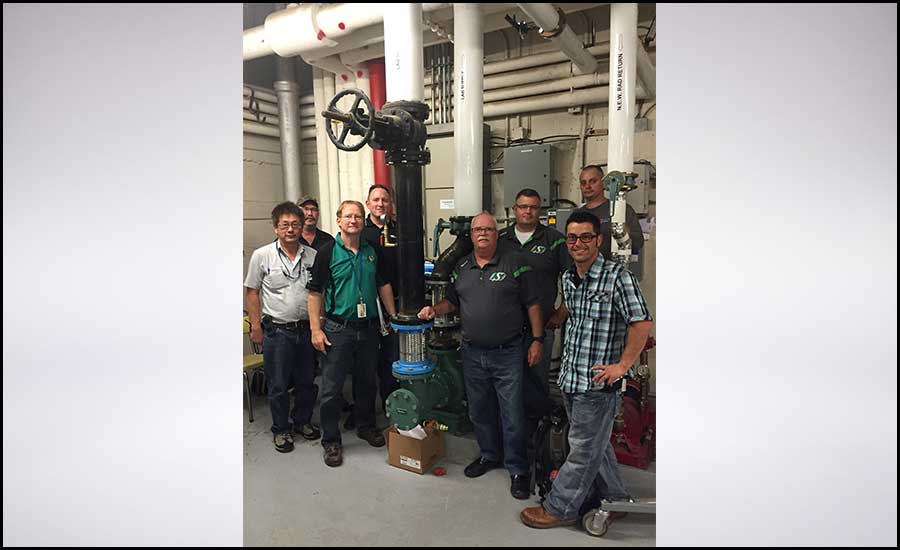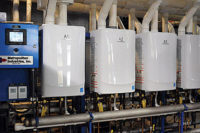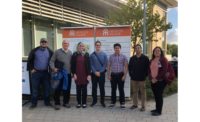For a decade, managers of Regina-based utility, Saskatchewan Power (SaskPower) in central Canada, serving about 550,000 customers, have methodically encouraged users — especially large corporations and institutions — to reduce electrical usage. SaskPower offers broad incentive programs to encourage energy reduction. Among its key targets are those customers that operate commercial and industrial pumps.
With the wild swings in weather and temperature in Saskatchewan, pumps are often busy switching from heating to cooling and back to heating again, all in the same day. So, it’s no wonder that SaskPower is trying to reduce the power required by HVAC systems, especially among larger consumers, like health care facilities, government buildings, and, more recently, educational institutions.
The University of Regina, one of the region’s largest institutions, is broadly recognized as one of the early adopters, quick to embrace sweeping energy reductions.
“SaskPower has efficiency and conservation programs in many sectors of the market,” said Dallas Munroe, industrial program leader, SaskPower. “As part of our planning for future power generation, we also offer educational programs to encourage people and businesses to reduce power usage. It’s cheaper to save a kWh than to build the next one — for both SaskPower and the customer.”
Set on 239 acres of Canadian prairie land, the University of Regina has a rich history, starting as a small high school established in 1911 by the Methodist church. The university now has more than 16,600 students on its multiple campuses and three federated colleges.
As a growing center for education and research, the university looked to its 2015-2020 strategic plan, which included sustainability as one of its driving forces. With that in mind, university managers scrutinized its HVAC systems, making them the No. 1 target in reducing power consumption.
Ailing Pump Provides an Opportunity
In 2015, a large, constant-flow hydronic pump that served the lab science building was about to self-destruct, so the facility staff decided to replace it with an upgraded version. The existing pump was rated at 10 horsepower (hp), providing 490 gallons per minute (gpm) of flow at 45 feet of head. It served a secondary, high-temperature heating loop in one of the university’s buildings.
The trick was to find a pump that would use less power without the need to modify the system — something that would then require costly upgrades to the controls.
A first, off-the-shelf retrofit would entail shifting from a constant flow pump to variable flow, an upgrade that typically requires adding pressure sensors at precise locations in the system while connecting to the building management system (BMS) and pump driver (a variable frequency drive [VFD]). The sensor feedback is then used to increase or decrease pump speed as the system needs it.
“If you get the sensor locations perfect, the energy savings can be quite significant,” said Mike Miller, director of sales, commercial building services, Taco Canada.
He points out, however, that this is almost never the case.
“In order to determine the best location for a sensor, it needs to be installed somewhere in the mechanical system that represents the longest run in the terminal unit, furthest away from the mechanical room,” said Miller. “Finding that spot is always a challenge, sometimes requiring moving the sensor multiple times.”
For this project, the university would require the services of a controls contractor and carry out more extensive engineering — costing precious time and money.
It’s important, however, to point out that this wasn’t the option they chose, thanks to advanced technology. Yet, the challenge remained: Was the latest technology applicable or available? The answer to those questions bore out (as Paul Harvey famously would say) with the rest of the story.
 FIGURE 2: The project team included (from left to right) Billy Cheung, service mechanic, University of Regina; Tim Forsythe, mechanical supervisor of preventive maintenance, University of Regina; Rob Kleisinger, manager of mechanical services, University of Regina; Mike Miller, P.Mgr, C.Mgr., director of sales, commercial building services, Taco Comfort Solutions, Canada; Laurie Walters, sales, HVAC; Chad Kuski, aftermarket sales manager, HVAC Sales & Service; Shane Wilkes, inside sales, HVAC; and Heath Hrappstead, refrigeration mechanic.
FIGURE 2: The project team included (from left to right) Billy Cheung, service mechanic, University of Regina; Tim Forsythe, mechanical supervisor of preventive maintenance, University of Regina; Rob Kleisinger, manager of mechanical services, University of Regina; Mike Miller, P.Mgr, C.Mgr., director of sales, commercial building services, Taco Comfort Solutions, Canada; Laurie Walters, sales, HVAC; Chad Kuski, aftermarket sales manager, HVAC Sales & Service; Shane Wilkes, inside sales, HVAC; and Heath Hrappstead, refrigeration mechanic. Taking a Bite Out of the Problem
In 2014, Rob Kleisinger, manager of mechanical services, University of Regina, attended a lunch-and-learn session at HVAC Sales Ltd., Taco’s rep firm, based in Regina, Saskatchewan. Taco sales pros provided a presentation about a new, self-sensing pump technology, which became a game changer at just the right time for the university.
Self-sensing pump technology ties its origins to programming of the speed controller at the manufacturing plant. To determine the pump curve for a typical pump, the pump is tested in the factory at one speed, 60 Hz, while the pressure (feet of head) is varied. At each increase or decrease in pressure, flow rate and power consumption are recorded; the pump’s performance curve is derived from these numbers.
Designers and engineers then use those curves to select the right pump for any given application based on required flow rates and estimated system pressure. Self-sensing pumps are tested in a similar manner but at a variety of speeds.
“For self-sensing technology, testing is done at various speeds like 60, 58, 56, and 54 hertz, and all the way down to the minimum speed of 20,” Miller said.
The results, rather than just sitting on a chart for a designer to look up, are programmed into the pump’s speed controller. When an engineer selects a self-sensing pump, he or she still does this based on estimated head and required flow rate. When replacing existing equipment, the new pump is selected to match the criteria of the one being replaced.
Once installed, the pump uses power consumption and speed to determine system pressure and flow based on the performance data recorded in the controller. It then adjusts speed in response to system needs with no sensors or external balancing.
 FIGURE 3: Chad Kuski, aftermarket sales manager, HVAC Sales & Service, walks toward Heath Hrappstead, refrigeration mechanic, University of Regina. The building on the left is the school’s original laboratory building.
FIGURE 3: Chad Kuski, aftermarket sales manager, HVAC Sales & Service, walks toward Heath Hrappstead, refrigeration mechanic, University of Regina. The building on the left is the school’s original laboratory building. Deadline in the Great White North
This was welcomed news to facility managers at the university. Soon, backed by the utility, they approached Taco to replace their ailing pump with this new technology.
Unfortunately, the pump being replaced was base-mounted, and no such pump was available at the time. Taco already had inline self-sensing pumps, but those were not an option for this application.
At first, Taco turned the project down because reps were unsure they could gear up for the request and meet the university’s deadline. Meanwhile, winter was approaching, and in the Great White North, heating is more critical than food.
Then, the troubled facility managers experienced some unexpected good news.
“We realized it was a great opportunity to showcase our technology,” recalled Miller. “Also, we had to consider the importance of doing everything we could to help out because the local utility had also shown interest in it.”
So, Taco plant managers were asked to forge ahead, post haste. In less than eight weeks, they shipped the very first SFI base-mounted, end suction, split-coupled, self-sensing pump in North America. The unit arrived just days before the university’s deadline and with temperatures dropping steadily outside.
 FIGURE 4: At the University of Regina, the presence of the truck of Heath Hrappstead, service technician for HVAC Sales and Service, a manufacturer’s rep with offices in Regina and Saskatoon, Saskatchewan, Canada, was a sign of his commitment to successful operation of Canada’s first installation of Self-Sensing pumps.
FIGURE 4: At the University of Regina, the presence of the truck of Heath Hrappstead, service technician for HVAC Sales and Service, a manufacturer’s rep with offices in Regina and Saskatoon, Saskatchewan, Canada, was a sign of his commitment to successful operation of Canada’s first installation of Self-Sensing pumps. Pump Power Consumption Takes a Dive
Kleisinger recalled the 2014 lunch-and-learn that he attended at HVAC Sales, where he discovered the pump’s ability to “learn” of its role in maintaining precise hydronic system flow.
“It processes information and responds to the amperage — meaning gpm — that’s required,” he said. “So, when we learned that a self-sensing pump could replace our old one, we were delighted.”
Before the replacement, the pump’s power consumption had been monitored, giving the university a solid baseline to compare with the new installation.
Self-sensing pumps have power-monitoring capabilities built-in since it is this power consumption that allows it to modulate its operation along the performance curve. This is the pump’s ability “to learn” that Kleisinger referred to.
Within the first week of installation, in September 2015, the pump’s power consumption dropped to 50% of its maximum while providing 255 gpm at 29 feet of head — just what the system called for at that time. The operating cost savings translated into a three-year payback.
“We’re aware of substantial energy savings with the lab science building’s hydronic system — now with the self-sensing pump in its sixth winter — especially during the shoulder seasons of spring and fall,” said Kleisinger. “This is when the finely tuned modulation of flow serves the facility so well. The old, constant-flow pump wasted a lot of energy, so we’re very thankful that we put a stop to that.
“Another huge benefit to the new technology was the speed at which it was installed,” he continued. “With self-sensing pumps, everything is self-contained. There are no external pressure sensors or drives, and no controls contractor was required during start-up or for later service.”
According to Miller, the university’s facility managers and engineering staff closely monitored the pump’s performance. An at-a-glance reference includes these statistics, supporting that expectation: Annualized electrical savings at the facility in 2016 (the first year when energy data was measured carefully) were $2,918.32. That gave them a payback on the $6,011 investment in just 2.06 years.
“Taco went over and above to get this pump to market so that we could provide the right solution for the university,” said Chad Kuski, aftermarket sales and service manager with HVAC Sales Ltd. “They not only shipped the pump ahead of schedule, but [Taco sales manager] Mike Miller along with a factory engineer travelled to Regina to assist with the start-up and commissioning of the drive. This added to the owner’s comfort level as Mike took the time to perform a full demonstration of the self-sensing pumps and was able to address all questions from the facility managers and technicians.
“This was further proof to us as the representatives that not only is Taco committed to introducing new technology for better solutions, but they’re truly committed to working with us as partners,” added Kuski.
The university isn’t alone in seeing energy savings attributed to self-sensing pump technology.
“We’re helping with the sale of this technology quite a bit now,” continued Kuski. “Installing contractors and facility managers are interested, paying close attention. The pumps have quickly become accepted in the engineering community as many realize how easy it is to implement this technology without the need for multiple contractors and the cost of wiring and sensors.”
In a SaskPower annual report, Mike Marsh, CEO and president, explained, “The electricity industry is changing. Technology and innovation are changing the way we create, supply, and use electricity. SaskPower’s story over the course of the last year focuses on how we are working through that change, providing the power our customers need while being mindful of costs and our changing operating environment. As we move forward, we will continue to make sure we are making sound financial decisions and will continue to improve efficiencies wherever we can.”
So, now, as yet another winter season is just around the corner for the University of Regina, facility managers are looking at other systems that could benefit from self-sensing pump technology.
Sidebar:
Self-Sensing Pumps Are Trending
When the University of Regina received its first self-sensing pump in 2015, it was the first recipient of this technology in North America. Since that time, the market has moved enthusiastically in that direction.
“There’s a very definite trend shifting toward this technology,” said Mike Miller, director of sales, commercial building services, Taco Canada. “By now, almost 40% of our pumps sold with drives come with self-sensing technology. Most of the pumps are applied for variable flow and used in the variable pressure mode. The same technology can be used for constant flow for large chillers and constant head for large domestic water system booster pump application.”
According to Miller, many of these new pumps are replacing older pumps to boost both system efficiency and system performance, providing variable flow for the first time.
“Often, it means taking a constant speed pump and giving it ‘system dynamic balancing’ by matching the pump’s output performance to building needs,” he said. “This is not a new strategy to increase system efficiency, though the substantial change — greatly improving performance — is to accomplish the retrofit without the use of external pressure differential (delta P) sensors.”
Previously, delta P sensors needed to be installed at the most ideal location in the system, which is generally near the largest pressure drop zone furthest away from the mechanical room. Not having them in that exact place often minimizes the effectiveness and lengthens the return on investment. That’s just one of the ways that self-sensing technology improves system performance.
“In most instances, building owners are investing in pumps with self-sensing technology to improve the energy efficiency of their buildings,” concluded Miller. “So, with energy prices expected to increase in the future, this kind of technology will eventually replace constant speed pumps. It’s just a matter of time.”




